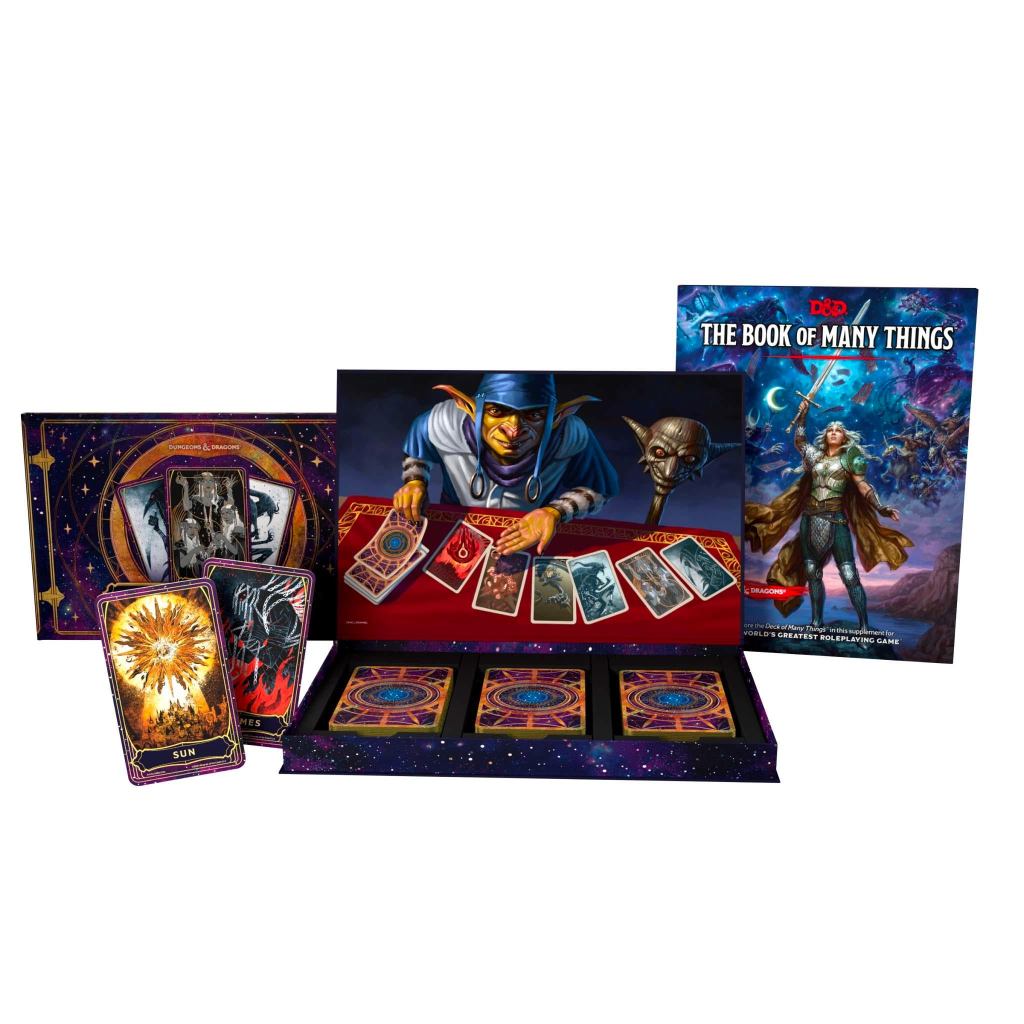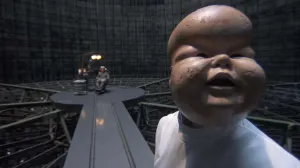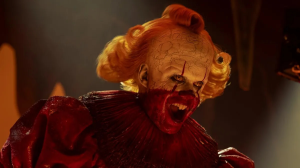The Deck of Many Things is an overpriced and overindulgent product that fills a niche that didn’t really need to be filled. Set to be released in November as a premium $99.99 product, The Deck of Many Things consists of a 66-card physical version of the Deck of Many Things (an in-world magic item, for those unfamiliar with D&D lore) and the accompanying Deck of Many More Things, an 80-page reference book on how to construct an adventure using a random selection of cards as inspiration, and a 192-page book called The Book of Many Things that serves primarily as a DM compendium in the flavor of Xanathar’s Guide to Everything or Tasha’s Cauldron of Everything, but without the robust player character options that made those books feel like full-fledged expansions to 5E. While the D&D Design team certainly tried to provide purchasers with enough value to justify the high price point, this ultimately feels like a lackluster cash grab outshined by both other Wizards products and third-party material.
Videos by ComicBook.com
The Deck of Many Things has long been one of Dungeons & Dragons’ most iconic magic items, having first appeared in the original Greyhawk supplement that served as the first expansion to the original Dungeons & Dragons rules. The item consists of a set of cards that each have their own magical effect, some providing fantastic benefits while others threaten the party with death or worse. Several iterations of the magical item has appeared in various versions of the game, with the most innovative appearing in Fourth Edition. In that version of Dungeons & Dragons, two Decks of Many Things appeared, both of which were sentient items with the sole purpose of sowing chaos and toppling powerful leaders regardless of their alignment. But from the beginning, The Deck of Many Things’ primary purpose has been to sow unexpected chaos in the game, daring adventurers to pull from it and either reap the rewards or suffer the consequences.
Because of the chaotic nature of The Deck of Many Things, crafting a rulebook themed around it was always going to be a challenge. The D&D design team attempt to sort this by crafting 22 chapters for The Book of Many Things, each one themed around a different card from the Deck of Many Things. Broadly, the 22 chapters are sorted into five distinct sections – a Dungeon Master toolset, character creation options, various organizations tied to the Deck of Many Things, a set of Adventure Locations, and finally a collection of “adversaries and rivals” that can be used in any D&D campaign. The Deck is also given a definitive origin, tied to an autistically-coded princess named Asteria and her life-long friend Euryale.

The Book of Many Things is at its strongest when it focuses directly on The Deck of Many Things itself – the magic items all appear to be solidly designed and flavorful, there’s a number of supernatural gifts that can be used in a Deck-focused campaign, and I enjoyed the monsters and adversaries sections, with the Grim Harrow (a group of undead born from the Deck who now attempt to destroy the Deck that cursed them) being a particular highlight. I also liked the House of Cards, the supernatural location where player characters’ souls are taken when they draw the Void Card.
However, other parts of the book just fall flat and seem like filler or are just devoid of inspiration. The locations and factions are especially guilty of feeling incredibly generic – the Seelie Market seems like a bland castoff from The Wild Beyond the Witchlight, while the new iteration of Gardmore Abbey pales in comparison to the design of the original Madness of Gardmore Abbey, the Fourth Edition adventure that included a version of the Deck of Many Things and is perhaps the strongest 4th Edition adventure published by Wizards of the Coast.
The four factions found in the book are also exceptionally disappointing – I was stunned by the lack of imagination used for the Heralds of the Comet, an apocalyptic cult that drapes itself with Deck of the Many Things imagery. The cult, for instance, has 22 Hierophants that are identified by a different card, but only has one statblock and no tips on how to make each Hierophant feel flavorful.
Equally disappointing is the Deck of Many More Things, which adds 44 additional magic cards to the set. While the original 22 cards in the Deck of Many Things are all campaign-changers, the 44 new cards are mostly bland and lack the danger and reward of the original. Whereas the original deck was equally divided between bane and benefit, the new cards are weighed much more heavily towards beneficial (a deliberate design) and is seemingly meant to water down the possibility of a player pulling a card that can break a campaign.
The worst part of The Deck of Many Things product is the 80-page reference book that comes inside the Deck of Many Things itself. This book shows how to use the Deck’s cards to randomly create either a campaign, adventure or dungeon by using the Deck of Many Things as an oracle deck. Part of the design is cribbed from Curse of Strahd’s tarokka deck reading, while the rest of the book includes very generic suggestions for each card. The reference guide tries desperately to be useful, but it ultimately feels like content added to the product solely to help justify its higher cost. There are plenty of other RPG tools that have used tarot or oracle decks to help craft campaigns in much more flavorful and fulfilling ways, and this reference book just falls flat in comparison. The reference book in particular feels like something that won’t see a lot of use – are there really DMs out there that are going to pay $100 for a Dungeons & Dragons product but struggle to come up with campaign ideas?

What’s frustrating about The Deck of Many Things is that there are the seeds of a really compelling campaign adventure within this product. The NPCs, the adventures, the various magic items – almost all of them can probably be combined to make for a very cool Deck of Many Things adventure in the vein of Madness of Gardmore Abbey. However, the weird decision to not just….make this product focused around a very flavorful campaign concept and instead water down everything down so that it could be marketed for a wider audience ultimately makes this product feel flat, especially as it makes everything in the product seem like add-ons for a physical version of the Deck of Many Things with nice art and cool foil effects, but doesn’t stand out compared to the thousands of similar tarot decks, oracle decks, and even other physical Decks of Many Things that are out in the market today.
Ultimately, The Deck of Many Things just doesn’t live up to its price tag. There are some interesting concepts contained in The Book of Many Things, but the rulebook and accompanying deck of cards is not enough to justify one of the most expensive 5E products produced by Wizards of the Coast to date. If you’re going to try to sell a $100 product, it should be exceptional and this just feels like a hodgepodge of big whiffs and interesting concepts that aren’t given the space to be fleshed out. No offense to the design team that clearly put a lot of time and energy into this, but this feels like a cash grab in the worst way. The one silver lining is that The Book of Many Things is also available for $29.99 on D&D Beyond, which is precisely how much I’d pay for that book.
The Deck of Many Things will be released on November 14th. Wizards of the Coast provided a review copy to ComicBook.com that was used for this article.








